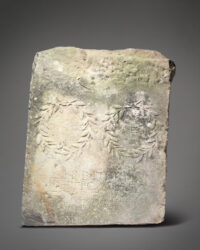A slab of marble used for a decade as a horse mounting block in a stable in Wiltshire, England, has been identified as a 2nd century A.D. dedication from somewhere in the Roman Empire’s territories in Greece or Asia Minor. How it got there is a mystery.
 The slab was first discovered two decades ago in the garden of a bungalow in Whiteparish, but at the time the owner didn’t realize it was anything but a usefully heavy hunk of stone among many in the rockery. She eventually moved it to her stables and used it as a booster step. It wasn’t until recently that she noticed there was a laurel wreath carved into the slab. An archaeologist then examined it, rediscovering its ancient inscription.
The slab was first discovered two decades ago in the garden of a bungalow in Whiteparish, but at the time the owner didn’t realize it was anything but a usefully heavy hunk of stone among many in the rockery. She eventually moved it to her stables and used it as a booster step. It wasn’t until recently that she noticed there was a laurel wreath carved into the slab. An archaeologist then examined it, rediscovering its ancient inscription.
There are two wreaths, respectively encircling the words “people” and “young men” written in Greek. Beneath the laurels the inscription reads “Demetrios (son) of Metrodoros (the son) of Leukios.” It’s a dedication from the people and young men of wherever this came from to the honor of Demetrios. The language and style of writing date it to one of imperial Rome’s Greek-speaking provinces.
Tracing its origins and movements will be a challenge. The owner has put the slab up for auction at Woolley and Wallis in Salisbury which has launched an appeal to the public for any information about its past.
“Artefacts of this type often came into England as the result of Grand Tours in the late 18th and 19th century, when wealthy aristocrats would tour Europe learning about Classical art and culture,” explained Antiquities specialist Will Hobbs at Woolley and Wallis. “We assume that is how it entered the UK, but what is a complete mystery is how it ended up in a domestic garden, and that’s where we’d like the public’s help.”
The bungalow on Common Road in Whiteparish was one of several built in the mid 1960s and the auctioneers are hoping that someone who perhaps lived in the area at the time, or who worked on the construction, might recall the origins of some of the rubble used.
“There are several possibilities of where the stone might have originated,” continued Hobbs. “Both Cowesfield House and Broxmore House were very close to Whiteparish and were demolished in 1949 after having been requisitioned by the army during the war. But we also know that the house at what is now Paulton’s Park was destroyed by fire in 1963 and so possibly rubble from there was reused at building sites in the area shortly afterwards.”
The slab was originally scheduled to go under the hammer at a February 16th antiquities sale, but the all auctions for January and February have been postponed for the time being. The pre-sale estimate is £10,000-15,000 ($13,600-20,400).